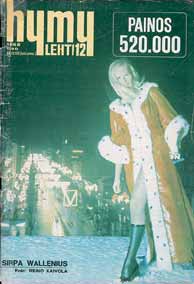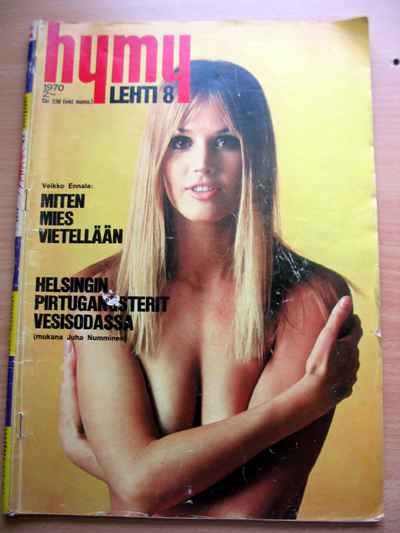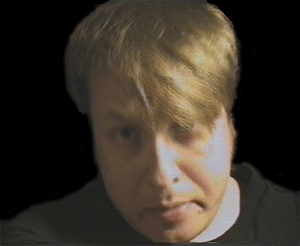
Miltei kohdusta hautaan minua seurasivat kalvava alemmuuden ja kyvyttömyyden tunne, kaiken ja kaikkien epäily, raskasmielisyys, tuska- ja paniikkitilat ilman silmin näkyvää syytä ja epätoivoinen kurottelu rehellisyyteen. Kirjoitin ymmärtääkseni miten asiat olivat enkä miten niiden olisi pitänyt olla. Tämän takia minulla ei juuri ollut ystäviä.
("Almost from womb to tomb I was followed by the nagging feelings of inferiority and impotence, doubts of everything and everyone, heavy melancholy, states of pain and panic without any visible reason and the desperate reaching out for honesty. I wrote to understand how things were and not how they should have been. Because of this I had few friends.")
- Veikko Ennala in his self-penned obituary, 1991
Veikko Ennala (1922-1991) was the enfant terrible of Finnish journalism, whose specialty was stirring controversy with magazine articles and columns penned by him, often of autobiographical content; breaking all possible taboos concerning sex, death, suicide, religion, alcoholism and substance abuse, crime and the general social conditions of those living on the wrong side of the tracks. Now a long-time Ennala aficionado Tommi Liimatta (of the band Absoluuttinen Nollapiste fame and a writer in his own right) has collected from the late journalist's writings this anthology, spanning nearly half a century, called Lasteni isä on veljeni ja muita lehtikirjoituksia ("The father of my children is my brother and other magazine writings").
The 1960s was a remarkable turning point when over 300.000 Finns emigrated to Sweden after a better living, and even inside Finland population moved from countryside to its large towns as the country which had been up until now predominantly agrarian rapidly turned towards industrialisation. This served to emphasize all sorts of social frictions which became all the more visible now when the newly settled dwellers of towns often faced -- instead of the economical Eldorado with better living standards that they had been expecting -- urban alienation which replaced the cosy rural way of life they had been earlier on accustomed to: where the bonds between families, relatives and neighbours had been tight, and life went on relatively unchanged from one generation to another. In fact, the whole Finland had been up to the 60s one large village with strict and homogenous ways of thinking; the combination of Evangelical Lutheran religion and Fennomanic patriotism providing the tight moral framework for all citizens, from which any diversion was heavily frowned upon.
So, all this suddenly changed in the 60s; not to talk about the onslaught brought on by TV, media and all kinds of new cultural and social values. In the 1966 Parliamentary Election, the Left (Social Democrats and Communists) received a landslide victory and the Conservatives found themselves in the opposition (which lasted all the way to 1987). The young intelligentsia found themselves radicalised, which was reflected in all domestic cultural life. The overall global tumult of the decade has been well documented elsewhere, so suffice it to say that Finland wasn't left unaffected, though the era's socio-sexual-cultural revolution came to this country at least slightly delayed, filtered and customised to the local mentalities. However, this all was reflected by Finland's most sensationalist magazine, called Hymy ("Smile"), which was established already in 1959 by a budding publisher mogul and Hemingway-wannabe Urpo Lahtinen (1931-1994) and named after his then-wife, Hymy Lahtinen. It took over half a decade for Hymy magazine to gain momentum and reach its full throttle, but when Veikko Ennala -- who had already gained some journalistic notoriety -- joined its ranks in 1965, the time was ripe to shake things up in tepid Finnish culture.

By no means was Ennala alone responsible for Hymy's subsequent rapid ascent -- which reached its apex with the December 1968 issue, the total edition of 520.000 which was sold out, becoming the best-selling Finnish magazine of all time -- but he became to personify the magazine's journalistic agenda, which consisted of a combination of "human interest stories", accounts of all kinds of social and political injustices, celebrity interviews and naturally gossips, sensations and scandals. All sorts of illicit sex or unusual sexual behaviour, homosexuality (which those days was still a criminal offence) and perversions were in the special spotlight, often analysed in a pseudo-scientific way, and all articles naturally accompanied by revealing photographs, so that by the 70s Hymy could well be called a soft porn magazine, though one browsed through by all family, either in public or more or less in shameful secrecy.
Accounts of both physical and mental illnesses and their countless appearances filled the pages of Hymy. Crime and the asocial lives of alcoholics, drug users and addicts were covered; also the primitive and severe conditions under which inmates had to live in correctional institutes and the poor people in countryside. The abuses of religious revivalist movements were exposed, even though also paranormal phenomena and ghost stories had their place on the pages, when all things mystical enjoyed some new-found interest in the Aquarian climate of the 60s. In other words, nothing human (or inhuman) was alien to Hymy magazine; everything that whetted the imaginations of star-struck sensation seekers and potential Peeping Tom types was covered.
Though America had "Gonzo" writers like Hunter S. Thompson and "New Journalism" represented by Tom Wolfe (in the style of his Stateside "counterpart", Ennala also liked to dress dandy-like; like Wolfe, favouring posh white suits), perhaps somehow distantly related to Ennala's style, it's hard to imagine that a character like Veikko Ennala would have been produced by any other culture, with that specific Finnish combination of Arctic hysteria, melancholia, mania and depression finding all their expressions in his work full of angst and lust. The workaholic Ennala estimated that as a writer he had produced approximately 30.000 - 50.000 sheets of A4 size during his life. Despite that, he was also a stylistic perfectionist, who advised that every text has to be written over at least for six times. His style is peppered all over with literary and poetry quotes; apparently the cultured Ennala was not exactly one of your typical gutter press hacks, and might as well have taken a successful career in "fine literature" (he actually also published some novels and short stories), but why he chose scandal press instead, must have been a question of some very complicated circumstances and perhaps just a personal tendency as a social misfit to go against the grain.
Admittedly, Ennala's style can be at times corny and downright soppy when he attempts with poetic turns of phrase to paint a picture of the hard fates of his long-suffering subjects but only ends up with voyeuristic saccharine melodrama, which makes him look look a pretentious hypocrite, albeit one who knows his world literature; just like "Olli Meri", a caricature of Ennala the late film director Risto Jarva depicted in his 1972 Kun taivas putoaa ("When the Heavens Fall..."), a tragicomical satire of yellow press, especially based on Hymy magazine.
The Ennala articles in this book are collected not only from the pages Hymy but also men's magazines published under the umbrella of Lehtimiehet, Urpo Lahtinen's company, such as Nyrkkiposti, VIP, Ratto, Jallu and Kalle. From the 1950s are Ennala's articles for Apu magazine where he worked with another legend of Finnish journalism, Matti Jämsä (1929-1988), known for his daring death-defying escapades which he reported for the magazine. (Ennala got kicked out of Apu after a scandal of getting sexually involved with a 15-year old girl.) The earliest Ennala stories are from the 1940s when he worked during the Continuation War as an official war correspondent for the Information Department of the Headquarters. However, Ennala's ambitions to become the next great war writer à la Erich Maria Remarque were hindered by the censorship of high brass, who were annoyed by the realism of Ennala's combat report, unworthy as any spirit-raising propaganda, for the esteemed Suomen Kuvalehti magazine. Famous writer Olavi Paavolainen, Ennala's superior officer at the Information Dept., called young Ennala his "literarily gifted problem child". After the war Ennala also had his own column at the local newspaper of Valkeakoski, writing as "Veli-Pekka". His last articles Ennala wrote in the 80s and just before his death in 1991 for the crime magazine Alibi.
The texts here are not in chronological order but the editor Liimatta has arranged them into such thematic categories as Ennala's life, reportages, religion and church, sexuality, little man and society, alcohol and drugs, prisons and mental health, paranormal and mysticism, celebrities, columns by Veli-Pekka for Valkeakosken Sanomat, and more Ennala's life.

Some examples of Veikko Ennala's texts found from the pages of this book:
Ennala reported in sardonic tones a characteristically bacchanalic Midsummer celebration on the Yyteri Beach near the town of Pori, known for its seaside dunes and camping site. Finnish youth drunk out of their minds, I witnessed this same Midsummer inferno of Yyteri myself decades after Ennala, to notice Finns still stick to their beloved paganistic Juhannus traditions of drinking, fighting, knifing each other and drowning.
Ennala was supposed to test some LSD and write a story, but gladly his editor prevented this, being aware of the writer's tendency to heavy melancholy and depression. Instead, a young graphic artist of Hymy took the substance, Ennala and the editor monitoring the proceedings and the former writing a story, not forgetting to duly repeat the LSD horror stories the late-60s media was full of.
Ennala was constantly annoyed by his reputation as a lecherous old man, an "emperor of porn", for which his children got bullied at school, but only added petrol himself to the flames with his articles such as "How To Seduce A Woman", and his infamous condom test for which he announced for a female willing to do the test with him (and found one). However, among tons of angry letters, Ennala also received from the more liberal-minded readers praise for his candid articles about sexuality and willingness to write about some of those subject matters which had been so far taboo in the puritanist Finnish culture.
There is something of a reckless exhibitionism about the way Ennala opened to all people through his writings his personal life, drunken binges with their violent hangovers, problems with his health and marriage, though all accounts were spiced with loads of sardonic self-irony and morbid humour. There's a detailed report of his ulcers for which he was hospitalised in 1974, the surgical operation that followed and his convalescence; also his later -- and terminal -- lung cancer was duly reported by Ennala. It's always embarrassing to follow people who wash their dirty laundry in public, and Ennala -- the indisputable master of this -- is no exception with "Death of My Marriage", his bitter Strindbergian account of the failure of his marriage and the reasons leading to it. (Subsequently, the ex-wife committed suicide some years later, Ennala also writing another infamous article not included in this collection.)
One theme that followed Ennala all through his career was his constant preoccupation with all things concerning death, afterlife and the existence of God, which he pondered on and on, though considered a blasphemer by religious bigots who kept bombing the writer with letters he claimed were often surprisingly obscene: another proof to Ennala of these people's basic sexual frustrations. Despite being a thorn by the side of fanatics, revivalists and self-made "prophets" and their eschatological claims of the imminent apocalypse and such things as glossolalia ("speaking in tongues") which he openly ridiculed, Ennala was an iconoclast who kept thinking about spiritual matters thoroughly and endlessly, who couldn't exactly decide if he was a believer (of sorts), an agnostic or an atheist.
Though it's not known if Ennala was familiar with the works of English visionary poet/artist William Blake, his own motto might well have been borrowed from Blake who wrote in his Proverbs of Hell that: "Prisons are built with stones of Law, Brothels with bricks of Religion". Veikko Ennala's attitudes about religion seem to stem from his childhood with his tyrannical teacher father (and occasional substitute priest) who regularly beat his wife and young Veikko into submission. (Somehow, these accounts make me think of those experiences depicted in his autobiographical Laterna Magica by film director Ingmar Bergman about his own strict priest father.) Veikko's religious faith was tried by father's cruel sadism and additionally, finding out about a "whoremonger priest" of his own parish, who had been found abusing young servant maids. Gladly father also had a vast library of world literature and Veikko nourished himself with the works of Edgar Allan Poe and Th. Hoffman (who also influenced Ennala's own short stories, the first of them published in a magazine when he was 11), Anatole France, André Gide, Alphons Daudet and Gustave Flaubert.
The book is concluded by Ennala's self-penned obituary that was published in Alibi #11/1991. Despite his shortcomings, Ennala was a unique character in Finnish journalism, and his passing at the age of 68 feels now like him having left us just too early. Even though the appreciation he was looking for during his lifetime seems to have been mostly posthumous: as one proof this excellent book.


1 comment:
Thanks for this, very interesting and well-written. I've been reading the same book for a review, but I don't know whether I'll post anything on my blog.
Some thoughts: the post-WWII generation also known for its radicalism somehow got obsessed with sex and voyeurism and exhibitionism, which is clearly shown in the how-to-have-sex picture books so prevalent in the late sixties and early seventies. It seems like a regression or something like that when one thinks about the rigid and violent fathers of that generation.
It's also very clear that Ennala was, mainly due to his own childhood traumas, very much incapable of receiving and giving love and showing nothing but contempt. The ones he feels sympathy for are those who are in the lowest ranks of the society and even then there's always his sarcasm and irony. The sympathy is always ambiguous at best.
But this is of course kitchen sink psychology.
The book is a bit too long, don't you think? It could've been shorter at least by 200 pages. It gets monotonous. And I don't see any reason for not including, for example, Jammu Siltavuori's ex-wife's interview.
I understood Liimatta will edit also collections of Ennala's short stories (of which there are dozens or even hundreds) and novels. The three novels he wrote were all paperbacks, strictly pulp. Maybe his childhood traumas really prevented him from trying to accomplish something true and lasting. (I don't mean to put down Ennala's paperbacks - the guy should've deserved better, that's all.)
Post a Comment